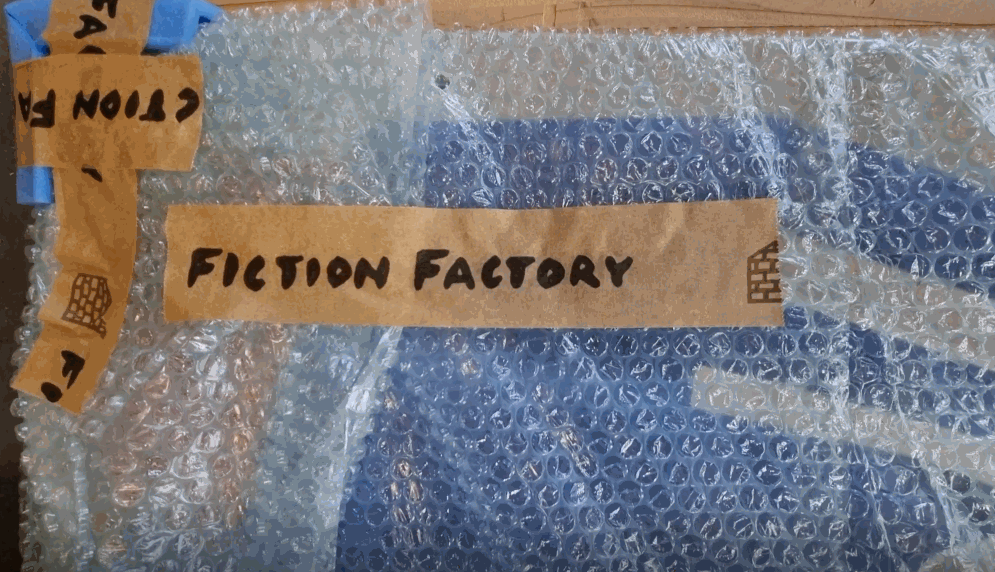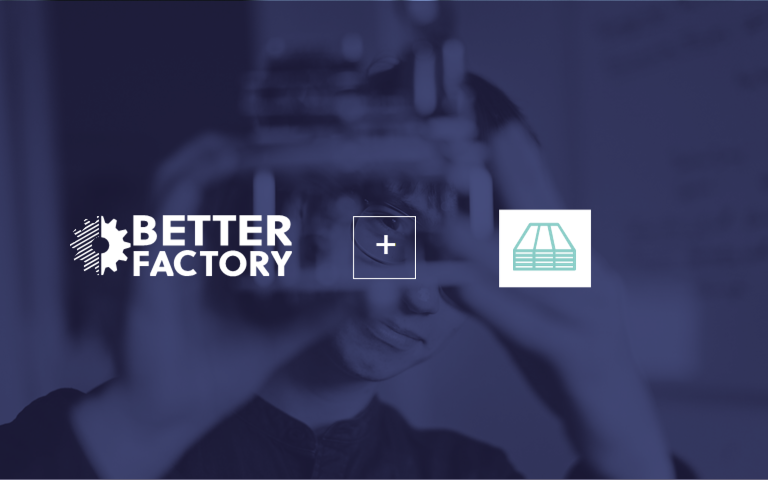Over the next couple of weeks we’ll be running a series of 1:1 interviews with the KTE (Knowledge Transfer Experiment) teams that joined Better Factory through our first open call. These incredible teams are each made up of a SME, artist and technology provider, working together to develop new and personalized products, become cyber-physical systems, and transforming into Lean-agile production facilities.
Today we are joined by BCF, otherwise known as ‘Better CNC Factory’, who are working on eliminating current wood waste, and creating a new approach for flexible object manufacturing based on machine learning-enabled programmed object specifications.
Their all-star team includes:
- Fiction Factory – Manufacturing company (Netherlands)
- Jesse Howard – Artist (Netherlands)
- IAAC (Institute for Advanced Architecture of Catalonia) – Technology supplier (Spain)
So let’s jump into the interview!

Why did you decide to apply to Better Factory?
Fiction Factory (Manufacturing company): Why? Because we are trying to produce in a more sustainable way. We found in research that by producing all our custom built interiors, we are producing a lot of waste, andnd a lot of work that we do comes from the CNC machine. So that’s why we think that there are the biggest benefits to gain from preventing this waste. For me personally, joining Better Factory was the combination of a tech company that’s working for us on the software side, but also the collaboration with an artist. Like thinking outside of the box. I think that’s the best combination for us because we work a lot with artists, but we are producing their art. But now it’s really nice that they are working on our progress. Especially this combination. And to find these collaborations with a platform like Ramp, starting to working in this way is really cool.
How do you think Better Factory will help you, given that you will be implementing the technologies that you didn’t have in the past.
Fiction Factory (Manufacturing company): Yes, indeed. We are not software engineers and the software that we need is not available at this moment because material is very cheap. So there is no incentive for the software companies that deliver the software with the machines to make it better. Right? So it’s more about tool changing, it’s more about making a faster path in the CNC sheet. It’s not only about preventing waste because you don’t earn so much money doing this. For us, it’s really necessary to work together to make it more customised for us.
Why is it important to you to implement circular design?
Fiction Factory (Manufacturing company): Well, Fiction Factory is a company that has existed already for 30 years. And to be honest, we have been creating waste for 30 years because everything that we build is very temporary and I think we should take our responsibility as a production company to prevent materials being wasted in a world where these are becoming more scarce, especiallyin an environment that’s changing and to take CO2 into consideration. This is something that we think we need to take responsibility for. And it starts with the design, right? If we design better from the beginning of the process, we solve a lot of problems at the end. So I always say the end is where you start from when thinking of the design.
What would you say is the biggest innovation that you are bringing to the table?
Jesse Howard (Artist): I think I’m following up on what was just said about starting from the beginning. I think this is, for me, asort of a fundamental switch to not thinking of waste as something at the end, but thinking about it as pre-planning for waste, and then using all of these technologies that can be implemented throughout the ground platform or through understanding the current situation in the factory, and how that can be transformed. With this idea of reconsidering the waste, we actually make use of it instead of ‘dealing with it’. So for me, innovation is more in the process and how you get that process into practice and into other designers’ practices, and then what follows are the technologies themselves that can make it happen.
Could you tell us about some of your other new products where you could implement the learnings from this project?
Fiction Factory (Manufacturing company): The project that we are working now is building a pavilion, and we’re making big logos for the outside made out of bio-based materials. It’s quite expensive material but it’s for the Dutch Pavilion, and is really where innovation has to be shown. For me, this was the right project to use as an example, or you could say as the first test. Thes logo are made out of a unique lettering, really ‘flower power’ style, and we need three of them (two big ones and one small one). The material is made with glitter from oyster and mussel shells, and costs about €200 the square metre. So even if we can save a little bit of it, it will be worth it and good, not just for us, but to show this innovation in action. For instance, we would like to create the two big ones, and then use the leftovers to make the small one, as well as save more waste. And then of course maybe we can reach out, I’m not sure how we will do this yet, to other designers to work together on this.
Jesse Howard (Artist): Yeah for me I think this is sort of a stage that… basically by having a very concrete project like this, to respond to, it becomes a kind of model. In this way, reaching out to designers is not necessarily to get new products or new solutions but more like, “okay, if we have this way of thinking how do you, as a designer, approach it differently than I do, or than an engineer does”? So I’m also looking forward to not so much the specific proposal but the different ways of thinking that start to come into the project.
Fiction Factory (Manufacturing company): And it has to be finished on the 14th of April, or a little bit earlier because the King is coming on the 13th April. It’s quick prototyping as well. So this is really nice to see, to have this already in the process. We are on course, on the right road to making the first test.
You already indicated in the proposal the impacts of your project, but I would like to ask you what do you think are most important economic, technical and societal impacts more specifically?
Fiction Factory (Manufacturing company): Well we are not the only ones. We have CNC machines, right? There are CNC machines all over the world. So if we find a solution for this, we can of course save a lot of material from being wasted. That saves you money.
Joining Better Factory was the combination of a tech company that’s working for us on the software side, but also the collaboration with an artist…. thinking outside of the box.
Fiction Factory (Manufacturing SME)
And how can you have a technical impact when the project has finished?
Fiction Factory (Manufacturing company): Well, I think you can sort of go ‘technical’ a long way, but I think the technical world needs creativity. So I think this is something that I think a lot of companies lack: creativity and finding solutions. Jesse, do you have somethingelse to add?
Jesse Howard (Artist): Yeah, that’s clear, andalso maybe just to add to that, Fiction Factory is not the only company with a CNC machine. So I think there’s also something about this, kind of how things can scale, using that model. So in Fiction Factory now they produce per project, but suddenly being able to combine different projects together will allow the efficiency to be even higher. So therefore, the environmental pay off is even higher. But if you expand that more, this sort of model of not bringing forward one thing, but actually bringing more components from different things together, then you start to change it with this one thing, like I want to produce this way. Actually, it’s the conversation of what needs to be produced from this material and how can we use it best. So that’s sort of a long answer. But I think this, in a way, depends on technology to actually allow these different components to come together.
Fiction Factory (Manufacturing company): Efficient production, with a creative mindset, right?
As a go-to-market strategy, you are researching investment in creating a shared open platform for interior builders to connect new customers with your leftovers, in order to come up with new product design. This was taken from the proposal. Are you looking for a specific type of product with a specific market? Canyou tell us little bit more about this product that you have in mind?
Jesse Howard (Artist): Yes, for me it’s interesting, and bear in mind we’re still in the process of this conversation, but I find it super inspiring in a way that Fiction Factory doesn’t produce ‘products’. So in that sense, there’s not a specific product that we’re looking to make or to bring to the market, but everything that they produce is somehow already a collaboration. Like Maria said, they’re either producing for an artist, or a designer, or an architect, so I think that in the best sense, (and this is related to what you said before about the this ‘leftover space’),it’s seen ‘per project’ or ‘per approach’. So maybe in one project that’s a doorknob or a door handle that fits into the existing parts that have to be produced, and maybe in another thing, it’s something completely different, like a lamp or who knows, a radio.
Where do you think Better CNC Factory will be in ten years?
Fiction Factory (Manufacturing company): Oh, that’s a good one. Where will it be? Oh, my. Well, I hope it conquered the world. Right? But no, I have no idea. I think now, in our company, it’s this project that is going on, but not everyone is aware of it. If it really works and it really happens. I think they will be blown away and I think they will start using it themselves. So, I think that we don’t need other customers anymore, that we are really efficiently using it in our own projects. So maybe it’s even better to say that we won’t call it Better CNC Factory, it’ll just become the standard way of production.
Do you think for you, and this project, there will be strategies in terms of expanding or gaining more market share because you will be able to respond to a bigger number of requests from other customers, due to your processes being more standardised, and efficient?
Fiction Factory (Manufacturing company): I think that 80% of our work is already coming from the CNC machine. So you could say that if we become more efficient, we can do more with the CNC machine, and this will happen automatically. If we have more time left over, we could focus on that, but at the same time, we still need more people to handle all the work, so we don’t want to grow too fast. think for EAC there could be more possibilities there for them to make the software better and bigger. That could be an option.
Jesse Howard (Artist): I think for me for sure it’s not necessary about doing more, or getting more specific clients or ways of working. It’s rather that by approaching it collaboratively it does become a different way to be in touch with the way that production is happening and that’s a thread that has been running throughout my own design and artistic practice. So in this sense I think the it could be interesting to consider what happens when actually the thinking or the tools that come out of this are supplied to either other numerically controlled manufacturing processes, or other collaborations. Additionally, maybe as an outside view on Fiction Factory that I found in our proposal, is that even if it’s not necessarily about increasing efficiency to sort of make progress and to do more and to expand, there is something interesting about being able to really measure and say: ”okay, actually this is how efficient this project was produced”, which is super valuable for both existing and new clients.
If you’d like to learn more about BCF and their experiment, don’t forget you can check out their KTE page here, including a cool video!

